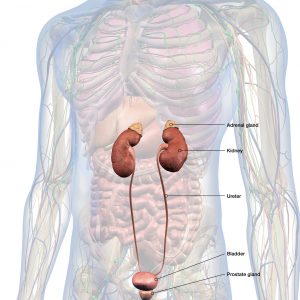Pheochromocytoma and Paraganglioma
Home » For Patients old » NET Tests & Treatments » NET Sites » Adrenal
Pheochromocytoma and paraganglioma are rare neuroendocrine tumors that occur inside or outside the adrenal glands.
Where are the adrenal glands?
There are two adrenal glands, one on top of each kidney in the back of the upper abdomen. Each adrenal gland has two parts: the center (medulla) and an outer layer (cortex). The adrenal glands make important hormones that control blood pressure, blood sugar, and help the body respond to stress.
- Pheochromocytomas form in nerve tissue inside the adrenal glands and near certain blood vessels and nerves.
- Paragangliomas form outside the adrenal glands.
What are pheochromocytomas and paragangliomas?
Pheochromocytoma is a rare form of neuroendocrine tumor that usually develops in the adrenal gland but can also arise in other parts of the body and be called paragangliomas. Pheochromocytomas/paragangliomas produce excess amounts of adrenaline and related hormones, which are the “fight-or-flight” hormones usually released in response to stress. These hormones can cause a person to have elevated blood pressure (hypertension) and an increased heart rate.
Symptoms of pheochromocytoma and paraganglioma
A tumor can overproduce and secrete excess hormones into the bloodstream, causing a range of symptoms. When pheochromocytoma and paraganglioma tumors release too much adrenaline or noradrenaline it may cause:
- High blood pressure
- Headache
- Heavy sweating for no known reason
- A strong, fast, or irregular heartbeat
- Being shaky
- Being extremely pale
Signs and symptoms of pheochromocytoma and paraganglioma may occur when one of the following events happens:11
- Hard physical activity
- A physical injury or having a lot of emotional stress
- Childbirth
- Going under anesthesia
- Surgery, including procedures to remove the tumor
- Eating foods high in tyramine (such as red wine, chocolate, and cheese).
Risk factors for pheochromocytoma or paraganglioma
Sometimes certain syndromes or gene changes passed down in families can increase the risk of pheochromocytoma or paraganglioma:11
- Multiple endocrine neoplasia 2 syndrome, types A and B (MEN2A and MEN2B)
- von Hippel-Lindau (VHL) syndrome
- Neurofibromatosis type 1 (NF1)
- Carney-Stratakis dyad
- Carney triad
Having someone in your family with one of these risk factors doesn’t mean you will develop this type of cancer, it just increases the likelihood.

Justin Annes, MD, PhD, Stanford University
Inherited risk factors for NETs. Watch Video
Daniel Halperin, MD, MD Anderson Cancer Center
Understanding tumor site, grade, and stage. Watch Video
Justin Annes, MD, PhD, Stanford University
Pheochromocytoma & Paraganglioma Watch VideoPatients and caregivers discuss lessons learned on their journey.
Patients and physicians discuss the importance of finding a specialist.
11Cancer.NET Editorial Board. Neuroendocrine tumor of the lung: symptoms and signs. 2018. https://www.cancer.net/cancer-types/neuroendocrine-tumor-lung/symptoms-and-signs. Accessed October 23, 2018.

